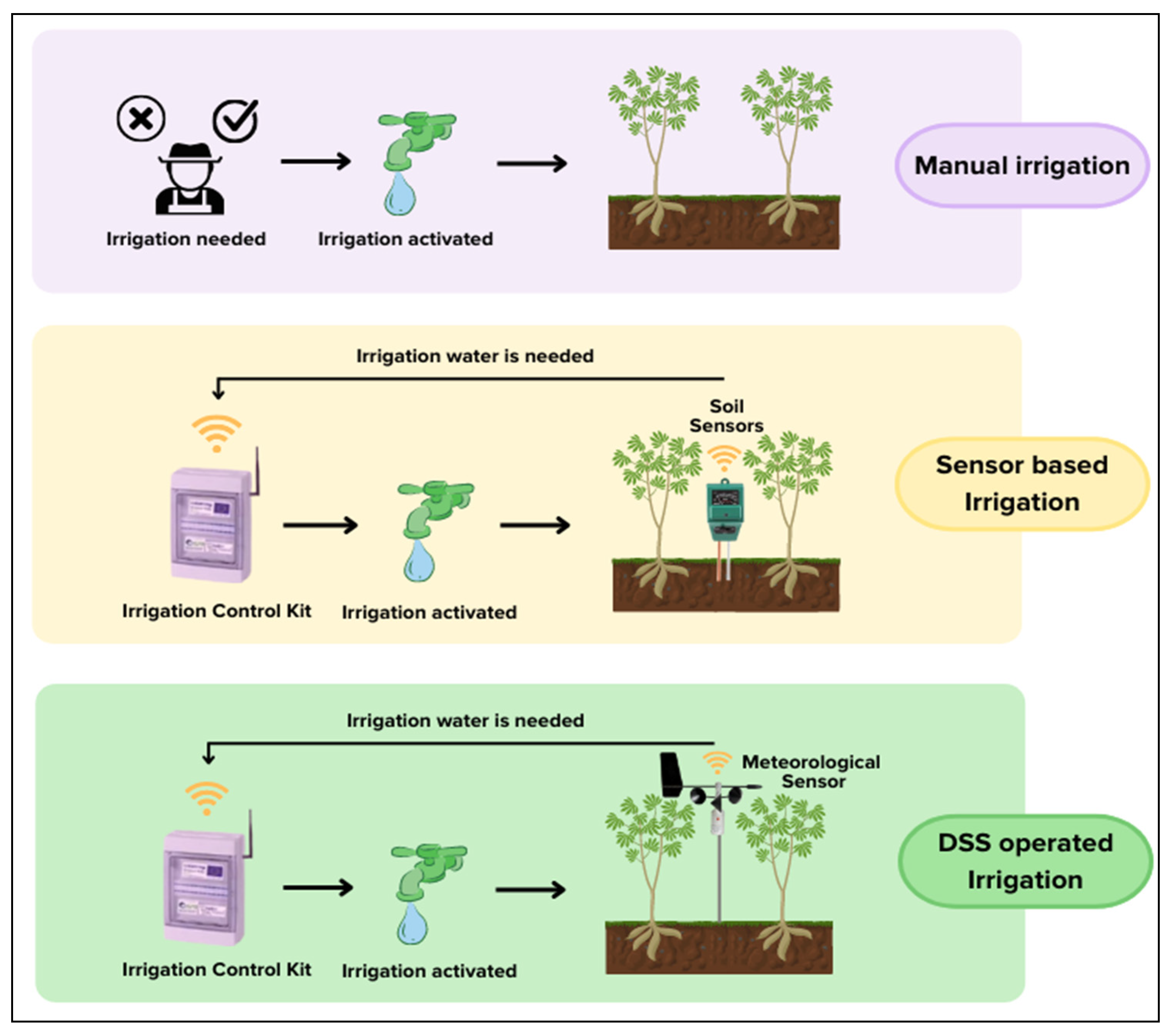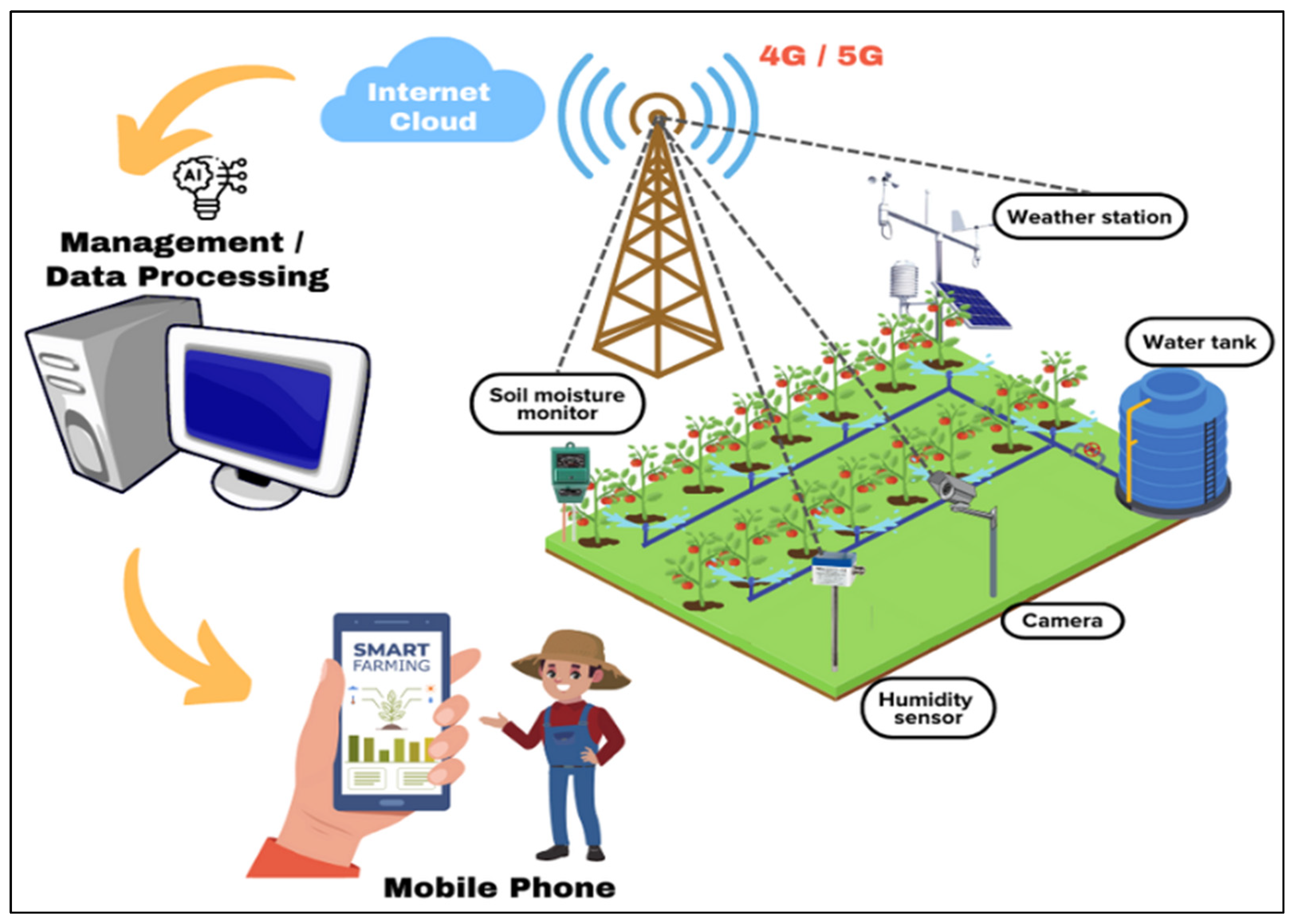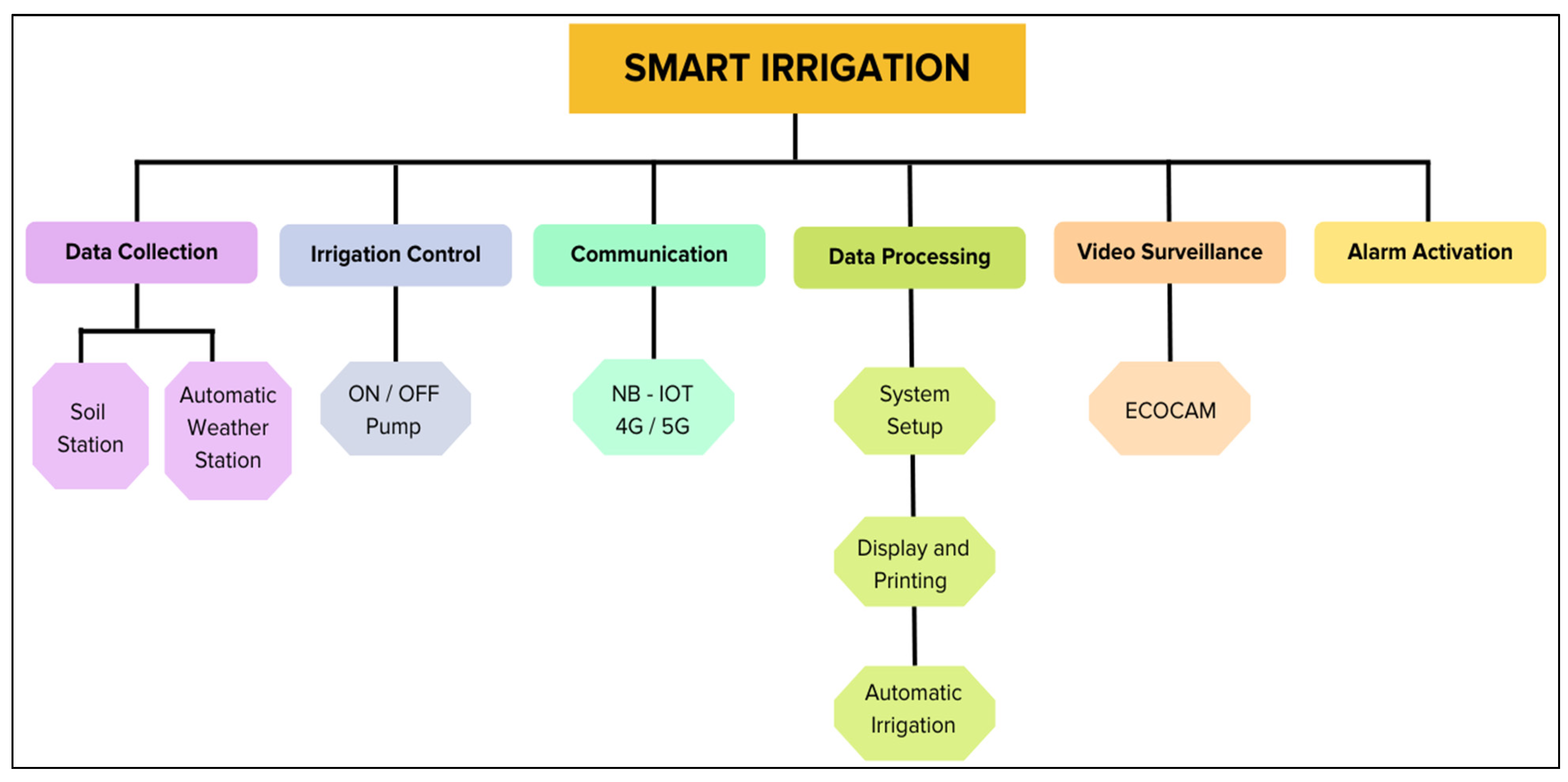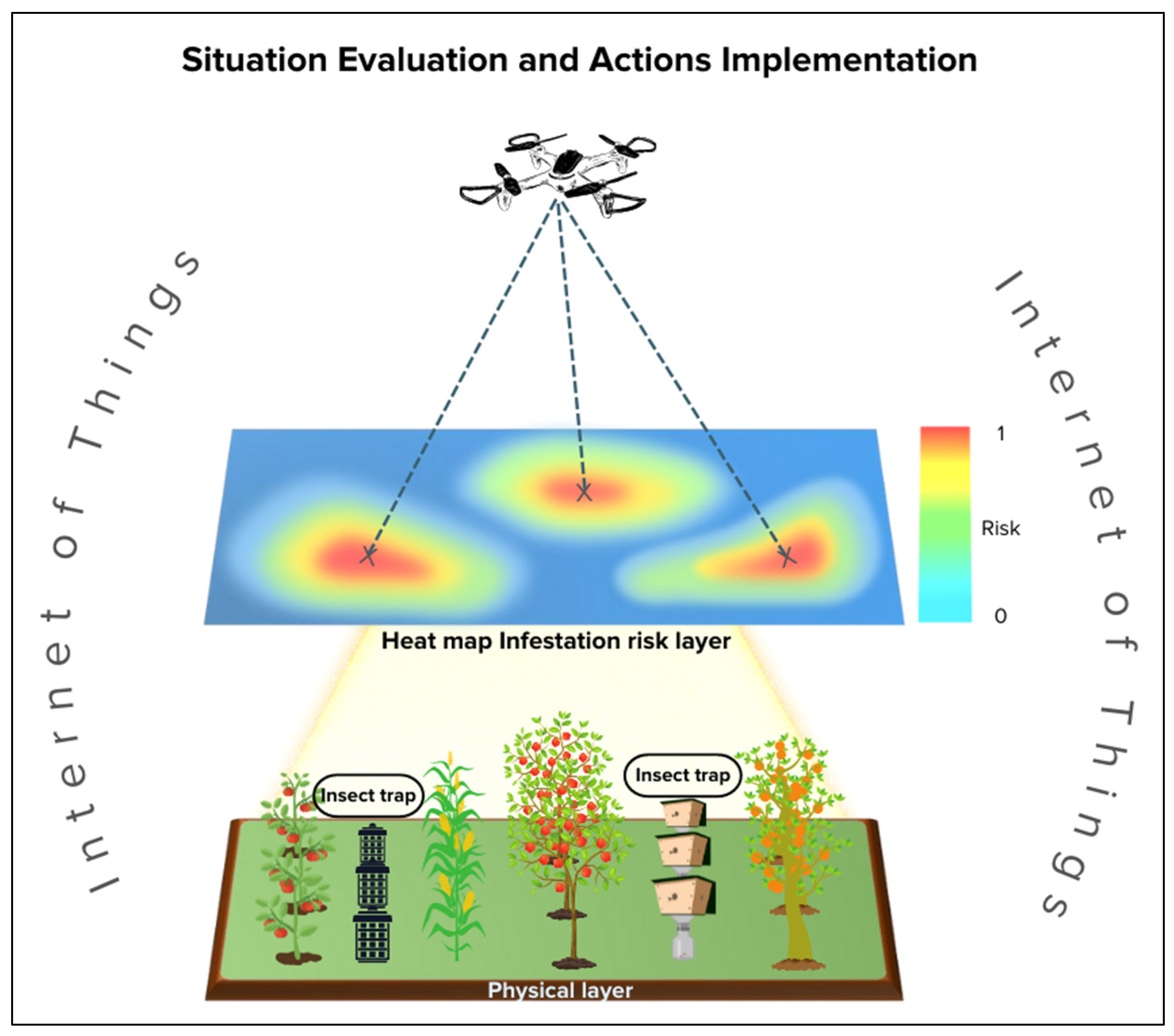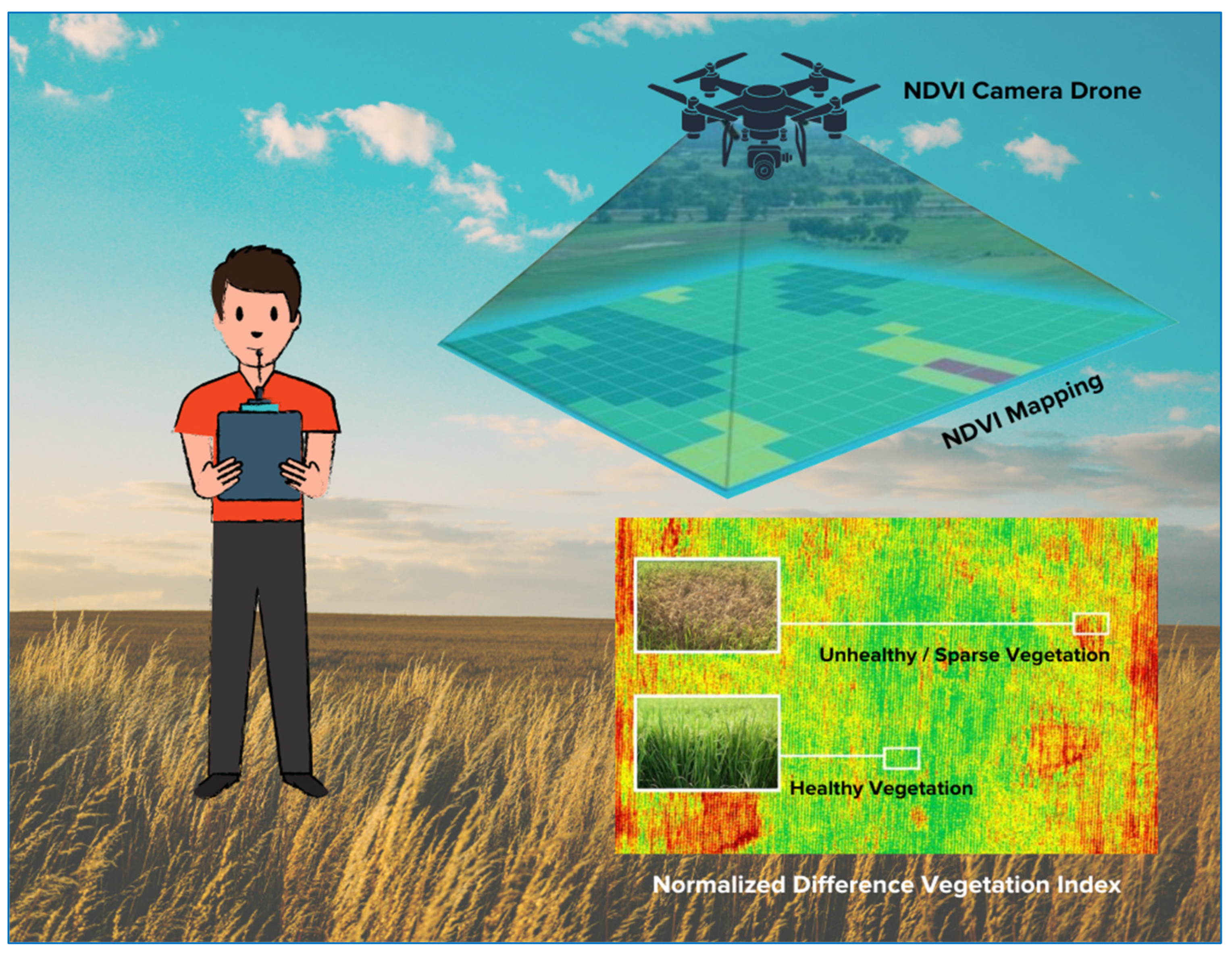1. Smart Irrigation Techniques
The water cycle has been substantially altered by climate change, which has also increased the severity of droughts
[1]. Hence, efficient water use in agricultural systems is a basic concern in the current scenario. The losses of water under limited water availability have gained a lot of interest in these days, when a major part of the world is susceptible to drought each year. Traditional and manual irrigation systems fail to accomplish water-saving goals, and are unable to supply water efficiently
[2]. Smart irrigation is a technique which is countering this problem efficiently by not just providing efficient water use, but also saving it for the future
[3]. Additionally, smart irrigation reduces the input costs, which provides relief to the farmers
[4]. Manual irrigation requires manpower for daily observations and scheduling irrigations by observing plants or crops in fields, but a sensor-assisted irrigation system detects soil moisture available in the soil profile and initiates the irrigation, making irrigation control better than the manual
[5], whereas a decision-support-system-assisted irrigation system integrates soil moisture sensors and climate sensors to observe water demand and control irrigation application for crops (
Figure 1). The development of accurate and effective irrigation systems has been aided by the revolution in decision-support-assisted irrigation systems, brought about by advancements in technology
[6]. This not only incorporated soil moisture and climate sensors, but also an internet-assisted cloud system for real-time data observation. Dynamic simulation models are linked to examine the effects of irrigation on crop growth and productivity estimation. Moreover, in accordance with data analysis and yield predictions, an irrigation quantity has been finalized and is supplied through an automatic irrigation control system. A remote control or mobile application
[7] is also linked up with this system for easy understanding and usage of the modern irrigation hub. A scheme of an advanced irrigation hub is presented as of
Figure 2.
Figure 1. Manual versus smart-sensor-based and decision-support-system-assisted irrigation applications.
Figure 2. Advanced irrigation hub assisted with real time weather and moisture sensors and decision support systems.
Smart irrigation consists of various steps and schemes, which are illustrated in
Figure 3, which, in combination, make this technique a revolution in agricultural production systems. Various techniques were developed and utilized to achieve efficient irrigation goals in smart agriculture systems. Automatic drip, sprinkler, real-time moisture-sensor-assisted, and predictive irrigation schemes are commonly being utilized
[8]. Various advanced irrigation techniques haven been developed and improved with time, and some of those are indicated in
Table 1 with their methods of data usage and objectives. Padalalu et al.
[9] presented a control system for an automatic irrigation, aiming to record and control the irrigation needs of the crop. Several variables, such as humidity, soil temperature, and pH, were observed by installing sensors. Additionally, a Naive Bayes algorithm was applied to estimate the exact water demand of the crop. Weather forecasts were observed to monitor the quantity of applied water to crops and the model of this intelligent irrigation system assured the intuitive use of water. An irrigation system based on the Support Vector Regression method was developed and proposed by Xie et al.
[10]. The system was composed of an irrigation demand estimation component to evaluate the energy and time needed for carrying out the subsequent operations. It was also composed of a solar energy prediction component for forecasting the solar energy.
Figure 3. Flow diagram of various components and processes of smart irrigation systems.
Numerical Weather Prediction (NWP) and the Time of Use price model (TOU) were employed, which exhibited clearly that the water resources and the amount of energy can be saved was up to 7.97%. Following the forementioned findings, costs declined by an estimated 25.34% when subjected to a comparison with the soil-moisture-based irrigation system. To maximize crop yields and to conserve an excess of water, Goumopoulos et al.
[11] devised a decision support system based on a Wireless Sensor/Actuator Network (WSAN). The system was positioned to observe irrigation in a greenhouse. Real-time monitoring for precision irrigation was provided by the developed system in it. Various sensors were considered, such as soil moisture sensors, humidity sensors, and temperature sensors, in strawberry field. The results from this research depicted a 20% decreased water consumption as compared to a traditional irrigation system. In another study, Zhang et al.
[12] performed experiments in the laboratory and in the greenhouses. A Fuzzy Logic-based irrigation control system was developed, and information was gathered from soil moisture sensors to decide the irrigation application time. The system came out to be a successful one in tackling the uncontrolled lengthy irrigation schedules. Peng et al.
[13] developed an irrigation system using WSN and Fuzzy Logic to save water. The system was composed of four parts: the cluster of sensor nodes, coordinator nodes, two variables as inputs (soil moisture error and the rate of change of the error), which provided watering time as an output. An irrigation controller was also used for automatic watering and monitoring of the pipe network, which eventually helped in precise and quick calculation of amount of water required in irrigation.
An automatic irrigation system was developed by Anand and Perinbam
[14] that consisted of four different parts. The first part was sensor nodes, which were collecting the temperature and moisture readings. The coordinator node, as a second part, the irrigation controller, as a third one, which was based on Fuzzy Logic to monitor the watering and the time of its application, and the irrigation pipe network, as the last component of their proposed system. The Fuzzy Logic-based controller was accounting for numerous activities in the automatic irrigation system. One such use was monitoring the water level in the tank. Likewise, it was also responsible for examining the amount of rain, the atmospheric temperature, and the wind speed. All the information which was under investigation, whether the field condition or the system itself, was collected and made available for the farmer through the GSM Module
[15]. The Fuzzy Inference System, another smart irrigation system for monitoring the evapotranspiration (ET) and irrigation, was developed by Mousa et al.
[16]. Goals were accomplished by using the specific algorithms such as the estimation of ET, soil moisture observations, required irrigation’s estimation as per reference ET (ET0), monitoring irrigation schedule, and the time of irrigation. Drip and sprinkler irrigation systems can be linked and applied successfully using this system. Moreover, results indicated the fuzzy model as an intelligent and quick implementation for recording the evapotranspiration and water needs of the crop field.
2. Smart Monitoring of Insects and Pests
In modern agriculture production systems, modern techniques are being utilized for smart monitoring and control of insects and pests. To spot six parasites in an apple orchard, Boniecki et al.
[17] suggested a neural classifier. The names of the parasites were apple blossom weevil, apple clearwing, codling moth, apple leaf sucker, apple aphid, and apple moth. The abovementioned classifier was established on 23 parameters, which included form and color characteristics. The former was 7 and latter was 16 in number. Decisive results were obtained by considering the Multi-Layer Perceptron Neural Network topology in the peach orchard. Rodrigues et al.
[18] used an extension of Fuzzy Logic, named Interval Fuzzy Logic, to predict the appearance of the parasites. Data was captured using temperature and humidity sensors, and processed by Interval Fuzzy Logic, which ultimately provided the warning levels. Different hardware components, such as the Arduino platform and different sensors, were used to develop this system. A demonstration of a drone-assisted evaluation of insects and pests in enabling the timely implementation of actions to remove the high-risk infestations is presented in
Figure 4. In addition, AgroDSS for agriculture, a new decision support system, was developed to learn the pest population by Rupnik et al.
[19]. This system relied on data mining approaches, and the implemented tools used were supervised learning, unsupervised learning, and time series analysis. The data was gathered by Trap View and allowed an efficient pest observation by using insect traps in the vineyards and orchard. When it came to deal with the missing data, linear regression was used by Da Silva et al.
[20], who also applied logistic regression while inspecting the results obtained from the land and the monthly surface temperature. They calculated “accumulated degree-day” by using a meteorological satellite to reduce disease risks by mapping the pests. A significant relationship was observed between the accumulated meteorological stations values and satellite values.
Figure 4. Evaluation of pests and encountering remedies in smart farming.
The crops lines algorithm, in association with the Convolutional Neural Network, was proposed by Bah et al.
[21]. The aim was to pin down weeds in various crops, such as beet, spinach, and bean fields. The research work was also assisted by the drone images, which were taken about 20 m height. The best accuracy in results were achieved in beet field. However, the research work also mentioned a few hardships concerning the right detection of the weeds. This usually happened when the plants were at early growth stage or when there was a less distance between weeds and crop. Various techniques for smart pest monitoring and its related goals are described in
Table 2. For an early alert and recommending necessary control measures, Tripathy et al.
[22] presented a real-time Decision Support System. The main objective was observing and predicting the pest and disease status in the field. Furthermore, numerous DM techniques have been used in groundnut crops, which were based on some climatic and weather parameters. The experiment was using the Naive Bayes method with Gaussian distribution. Rapid Association Rule Mining, in conjunction with the aforementioned technique, was performed to search out the multiple weather correlations with other related parameters. Doses of pesticides are an important indicator for the betterment of the crop, and they were predicted by Viani et al.
[23] by using Fuzzy Logic. Weather data (soil temperature and moisture) were considered, and the risk of infection was counted by examining developmental stages of the plant and the fluctuating environmental conditions. By combining hydroponics with IoT, Alipio et al.
[24] developed an efficient hydroponic system, which assisted in providing the right nutrient’s type and amount at the best suitable time. A Bayesian Network (BN) prediction algorithm was implemented to obtain the maximum of the right decisions to control the system. The three main components of the developed system were a data analysis module, a web interface, and sensors. The sensors used were controlling the electrical conductivity, managing pH, monitoring light intensity, recording humidity, and water temperature. For displaying the data and to control the system, there were two operational websites for this purpose. A clear increase in the yield obtained with the automatic control was observed as compared to the manual control system.
3. Smart Disease Management
Diseases in crops are devastating in terms of yield and deteriorating the quality of the produce. Numerous solutions are out there in the market and industries
[25][26], yet there is a need to think or perform smarter, to remove the excessive damage to the final product, and to enhance the outcome in terms of the revenue. In smart agriculture, the focus is on the classification of the diseases and its detection precisely at any stage
[27], so that smart decision making can be conducted and the excessive failure in the yield and quality can be avoided. A modified model image of smart disease management using normalized difference vegetation index (NDVI), drone, and imaging techniques is presented in
Figure 5. Singh et al.
[28] opted for the image processing technique using a genetic algorithm. In his research work, he observed and managed several leaf diseases on various crops, achieving the precision percentage of 88.99%. Likewise, 89.56% precision was achieved by Warne and Ganorkar
[29] while detecting the leaf diseases in cotton crop. They classified the diseases as red leaf spot and Alternaria leaf spot of cotton using a neural network algorithm. Similar research was performed by Revathi and Hemalatha
[30] while working on a cotton crop. Image processing was assisted by the neural network to detect and classify cotton diseases. In this research work, they classified Fusarium wilt and leaf blight with the high precision of 98.1%. Image processing by employing Support Vector Machine was performed by Bhange and Hingoliwala
[31], Yao et al.
[32], Jian and Wei
[33], and Dubey and Jalal
[34] to target teyla in pomegranate, rice blast and rice sheath blight in rice, downy mildew and brown spot in cucumber, and apple rot, scab, and blotch in apple. The results from these research studies have indicated the precision percentages as high as 82%, 97.2%, 94% and 93%, respectively, as represented in
Table 3.
Table 3. Methods and precision percentage for detecting and classifying diseases in smart agriculture.
This entry is adapted from the peer-reviewed paper 10.3390/agriculture13020397
